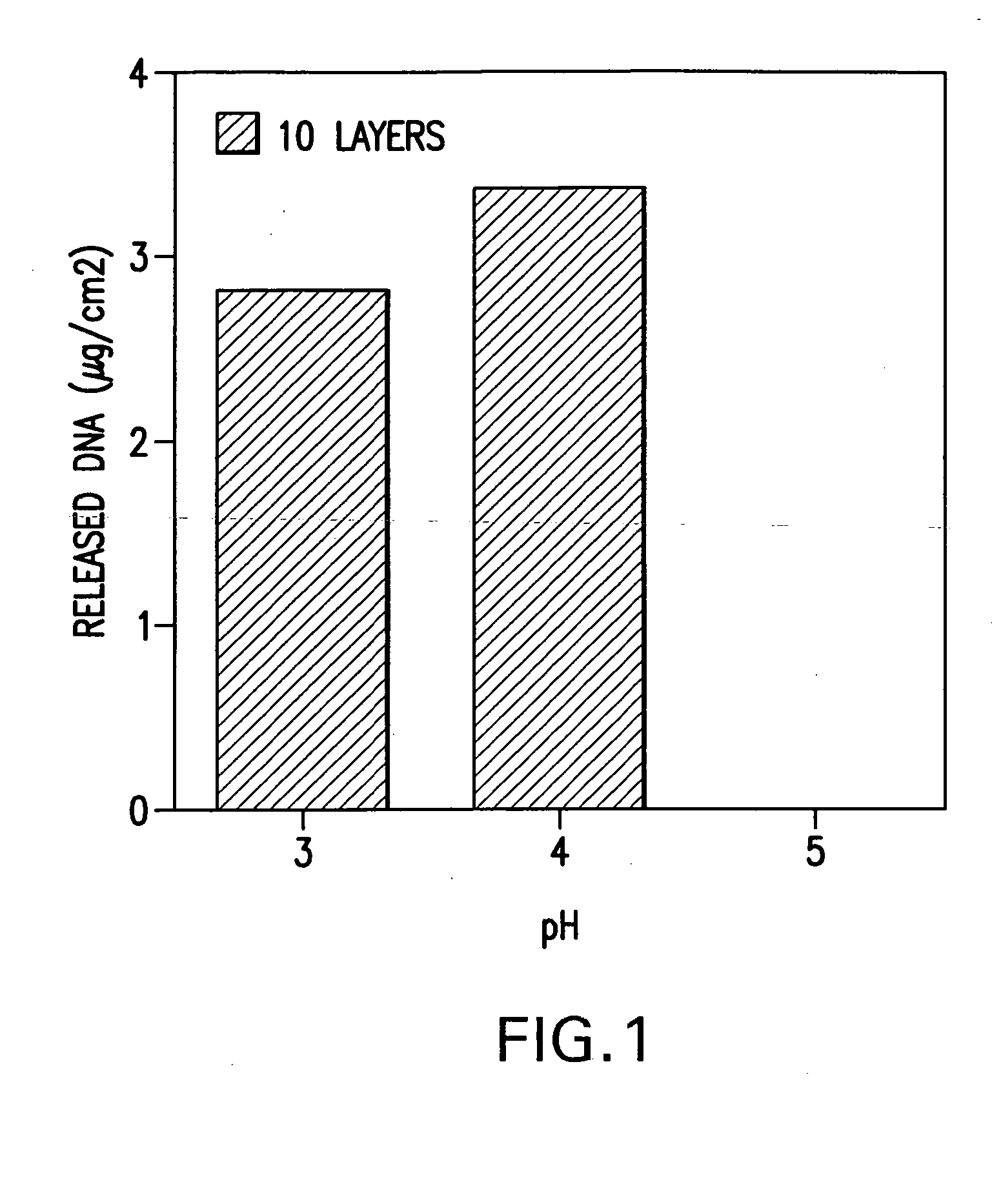Controlled delivery of therapeutic agents by insertable medical devices
a medical device and control technology, applied in the direction of biocide, prosthesis, catheter, etc., can solve the problems of uncontrolled release of drug or drug solution from the delivery device, and achieve the effects of linear increase in dna absorbed, and reduced release rate of adsorbed dna
- Summary
- Abstract
- Description
- Claims
- Application Information
AI Technical Summary
Benefits of technology
Problems solved by technology
Method used
Image
Examples
example 1
Effect of Surfaces and Polyelectrolytes on the DNA Release
[0059] Multilayered films of DNA were built up on various negatively charged, neutral, and positively charged surfaces, by spraying or dipping. The DNA adsorbed by HSA or gelatin was released quickly whereas, due to the hydrophobicity of chitosan at neutral pH, the DNA adsorbed by chitosan was released very slowly. The result of this experiment is tabulated in Table 1 below. Table 1 shows natural polymers, as polyelectrolytes, are coated onto several surfaces, which surfaces were modified by different substrates. When different surfaces were dipped into a slightly acidic solution containing a polynucleotide, the positively charged coated surface induced adsorption of the polynucleotide (i.e., adsorption was driven by the charged interaction). Successive layering of the surface with polyelectrolyte and DNA can be repeated as many times as needed to maximize the amount of DNA adsorbed to the surface. The alternate layers of po...
example 2
Effects of pH on the Amount of DNA Released
[0060] The effect of pH on the amount of DNA adsorbed was investigated by alternating adsorption of DNA and HSA at different pHs. The results, as shown in FIG. 1, indicated that HSA adsorption is optimal at pH 4.0; no DNA could be adsorbed at pH 5.0 or higher. The relationship between the number of DNA layers and adsorbed amount of DNA was investigated by alternating adsorption of DNA and HSA at pH4.0. The results, as demonstrated in FIG. 2, showed that the amount of DNA absorbed increased linearly with the number of DNA layers on the surface of the medical device.
example 3
The Release Kinetics of the Adsorbed DNA from the Surface of the Medical Device
[0061] Release kinetics studies indicated that the adsorbed polynucleotide could be released completely within 5 minutes. (See FIG. 3 which shows that the adsorbed DNA was released almost completely from the surface of a coated balloon catheter.) When the medical device is coated with a condensed gelatin coating, the release rate of the adsorbed DNA was reduced slightly, whereas when the device was coated with a thin layer of chitosan, the release rate of the adsorbed DNA was decreased remarkably. The release kinetics of the adsorbed DNA, as shown in FIG. 4, was also shown to be dependant on the thickness of chitosan coating (i.e., the concentration of chitosan solution when the dipping time was fixed).
PUM
| Property | Measurement | Unit |
|---|---|---|
| diameter | aaaaa | aaaaa |
| pH | aaaaa | aaaaa |
| pH | aaaaa | aaaaa |
Abstract
Description
Claims
Application Information
 Login to View More
Login to View More - R&D
- Intellectual Property
- Life Sciences
- Materials
- Tech Scout
- Unparalleled Data Quality
- Higher Quality Content
- 60% Fewer Hallucinations
Browse by: Latest US Patents, China's latest patents, Technical Efficacy Thesaurus, Application Domain, Technology Topic, Popular Technical Reports.
© 2025 PatSnap. All rights reserved.Legal|Privacy policy|Modern Slavery Act Transparency Statement|Sitemap|About US| Contact US: help@patsnap.com



